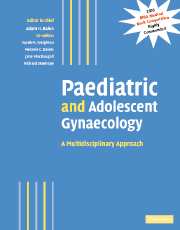Book contents
- Frontmatter
- Contents
- Contributors
- Preface
- Part I Normal development
- Part II Management of developmental abnormalities of the genital tract
- 9 Management of ambiguous genitalia at birth
- 10 Imaging of the female pelvis in the evaluation of developmental anomalies
- 11 Surgical correction of vaginal and other anomalies
- 12 Laparoscopic techniques
- 13 A nonsurgical approach to the treatment of vaginal agenesis
- 14 Psychological care in disorders of sexual differentiation and determination
- 15 The needs of the adolescent patient and her parents in the clinic
- 16 Communicating a diagnosis
- 17 Patients and parents in decision making and management
- Part III Management of specific disorders
- Index
- Plate section
- References
9 - Management of ambiguous genitalia at birth
from Part II - Management of developmental abnormalities of the genital tract
Published online by Cambridge University Press: 04 May 2010
- Frontmatter
- Contents
- Contributors
- Preface
- Part I Normal development
- Part II Management of developmental abnormalities of the genital tract
- 9 Management of ambiguous genitalia at birth
- 10 Imaging of the female pelvis in the evaluation of developmental anomalies
- 11 Surgical correction of vaginal and other anomalies
- 12 Laparoscopic techniques
- 13 A nonsurgical approach to the treatment of vaginal agenesis
- 14 Psychological care in disorders of sexual differentiation and determination
- 15 The needs of the adolescent patient and her parents in the clinic
- 16 Communicating a diagnosis
- 17 Patients and parents in decision making and management
- Part III Management of specific disorders
- Index
- Plate section
- References
Summary
About 1 in every 4000 infants is born with ambiguous genitalia (Hamerton et al., 1975). This event creates tremendous anxiety for the parents. Any health professionals involved in caring for them and the baby at the delivery will be immediately placed under great pressure to sort things out quickly. Under these circumstances, decision making is stressful, particularly for staff who are unprepared and inexperienced, and stress can increase the risk of mistakes. This chapter is intended to provide health professionals with clear guidelines on how best to proceed. The management of ambiguous genitalia at birth involves management of the medical condition in the infant and also management of the distressed parents, who become patients themselves. A team approach is required to provide the range of professional skills needed (medical, surgical, nursing and mental health) and the best team members for this situation are those with very good communication skills as well as clinical acumen.
Genitalia are “ambiguous” when they have an atypical appearance and no one in the room can decide if the baby is male or female. The phallus looks too small to be a penis and too large to be a clitoris. The urethra is malpositioned in relation to the size of the phallus, being usually on the shaft of the phallus or in the perineum. If there is a vagina, it may open into a urogenital sinus, so that there is only a single orifice.
- Type
- Chapter
- Information
- Paediatric and Adolescent GynaecologyA Multidisciplinary Approach, pp. 97 - 103Publisher: Cambridge University PressPrint publication year: 2004

